品牌管理与技术创新:南京新冠生园的品牌重塑与现代转型
冠生园品牌之争
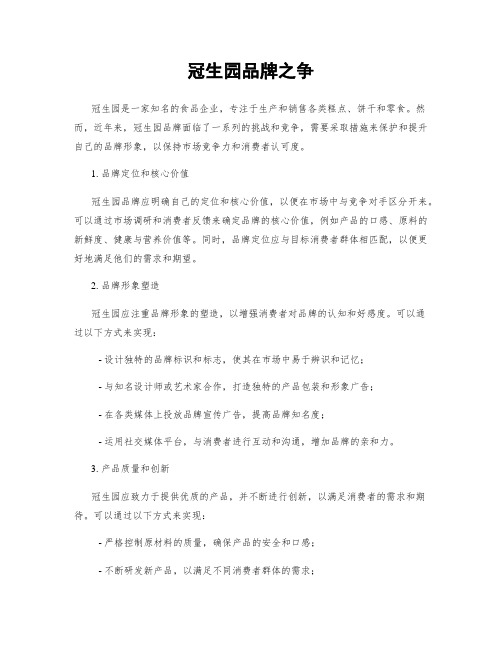
冠生园品牌之争冠生园是一家知名的食品企业,专注于生产和销售各类糕点、饼干和零食。
然而,近年来,冠生园品牌面临了一系列的挑战和竞争,需要采取措施来保护和提升自己的品牌形象,以保持市场竞争力和消费者认可度。
1. 品牌定位和核心价值冠生园品牌应明确自己的定位和核心价值,以便在市场中与竞争对手区分开来。
可以通过市场调研和消费者反馈来确定品牌的核心价值,例如产品的口感、原料的新鲜度、健康与营养价值等。
同时,品牌定位应与目标消费者群体相匹配,以便更好地满足他们的需求和期望。
2. 品牌形象塑造冠生园应注重品牌形象的塑造,以增强消费者对品牌的认知和好感度。
可以通过以下方式来实现:- 设计独特的品牌标识和标志,使其在市场中易于辨识和记忆;- 与知名设计师或艺术家合作,打造独特的产品包装和形象广告;- 在各类媒体上投放品牌宣传广告,提高品牌知名度;- 运用社交媒体平台,与消费者进行互动和沟通,增加品牌的亲和力。
3. 产品质量和创新冠生园应致力于提供优质的产品,并不断进行创新,以满足消费者的需求和期待。
可以通过以下方式来实现:- 严格控制原材料的质量,确保产品的安全和口感;- 不断研发新产品,以满足不同消费者群体的需求;- 关注消费者的反馈和意见,不断改进和优化产品;- 加强与供应商的合作,确保原材料的稳定供应和质量控制。
4. 渠道拓展和市场推广冠生园应积极拓展销售渠道,提高产品的市场覆盖率。
可以通过以下方式来实现:- 与超市、便利店等零售商建立合作关系,增加产品的销售点;- 开设自有零售店,提供更好的产品展示和销售服务;- 在线销售平台的建设和运营,以满足消费者的便捷购物需求;- 举办促销活动和参加行业展览,提高品牌知名度和销售额。
5. 品牌维护和危机管理冠生园应建立健全的品牌维护和危机管理机制,以应对可能出现的品牌危机和负面事件。
可以通过以下方式来实现:- 建立品牌危机管理团队,及时应对和处理各类品牌危机;- 加强与媒体和公众的沟通,及时发布准确的信息,以减少负面影响;- 建立消费者投诉反馈渠道,及时解决消费者的问题和投诉;- 加强内部管理,确保产品质量和服务的稳定性。
冠生园品牌之争

冠生园品牌之争一、背景介绍冠生园是一家知名的食品企业,专注于生产和销售各类糕点和饼干。
多年来,冠生园凭借其独特的产品口感和高品质赢得了广大消费者的喜爱,成为行业内的领军品牌。
然而,随着市场竞争的加剧,其他竞争对手也开始涌现,对冠生园的市场份额形成了威胁。
为了保持竞争力并进一步扩大市场份额,冠生园决定展开一场以品牌为核心的竞争。
二、竞争目标1.提升品牌知名度:通过广告、营销和推广活动,提高冠生园品牌在消费者心中的知名度。
2.增加市场份额:通过产品创新和市场拓展,扩大冠生园在市场上的份额。
3.提高产品质量:加强质量控制和技术创新,提高冠生园产品的质量和口感。
三、竞争策略1.市场定位:冠生园将以高品质、独特口感和健康食品为核心定位,与其他竞争对手形成差异化。
2.产品创新:冠生园将加大研发投入,推出更多新品种和新口味的糕点和饼干,满足消费者不断变化的需求。
3.品牌推广:通过电视、广播、互联网等多种媒体渠道,进行品牌宣传和推广活动,提高冠生园品牌的知名度和美誉度。
4.渠道拓展:冠生园将与各大超市、便利店等零售商合作,扩大产品销售渠道,增加市场份额。
5.客户关系管理:冠生园将建立完善的客户关系管理系统,通过定期促销活动和售后服务,保持与消费者的良好关系。
四、竞争执行计划1.制定市场调研计划:通过市场调研了解消费者需求和竞争对手情况,为制定竞争策略提供依据。
2.产品研发计划:加大研发投入,推出新品种和新口味的糕点和饼干,满足消费者的多样化需求。
3.品牌推广计划:制定品牌推广活动计划,包括电视广告、网络宣传、促销活动等,提高冠生园品牌的知名度和美誉度。
4.渠道拓展计划:与各大超市、便利店等零售商洽谈合作,扩大产品销售渠道,增加市场份额。
5.客户关系管理计划:建立客户关系管理系统,定期进行促销活动,提供优质的售后服务,保持与消费者的良好关系。
五、竞争效果评估1.市场份额:通过市场调研和销售数据统计,评估冠生园在市场上的份额变化。
南京冠生园 SWOT分析
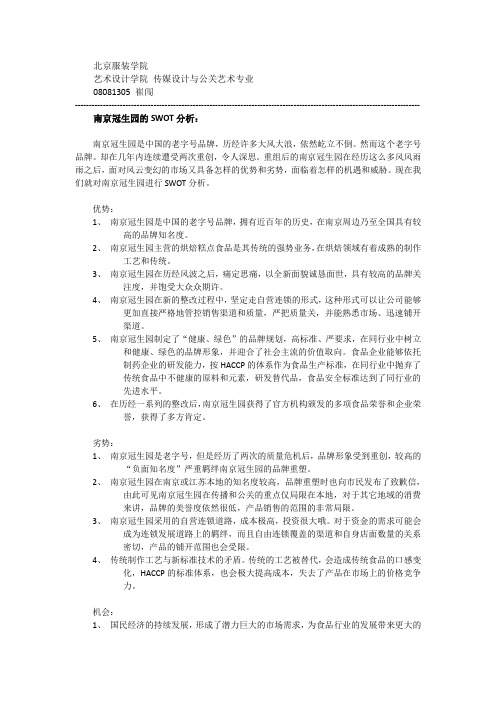
北京服装学院艺术设计学院传媒设计与公关艺术专业08081305 崔闯--------------------------------------------------------------------------------------------------------------------------- 南京冠生园的SWOT分析:南京冠生园是中国的老字号品牌,历经许多大风大浪,依然屹立不倒。
然而这个老字号品牌。
却在几年内连续遭受两次重创,令人深思。
重组后的南京冠生园在经历这么多风风雨雨之后,面对风云变幻的市场又具备怎样的优势和劣势,面临着怎样的机遇和威胁。
现在我们就对南京冠生园进行SWOT分析。
优势:1、南京冠生园是中国的老字号品牌,拥有近百年的历史,在南京周边乃至全国具有较高的品牌知名度。
2、南京冠生园主营的烘焙糕点食品是其传统的强势业务,在烘焙领域有着成熟的制作工艺和传统。
3、南京冠生园在历经风波之后,痛定思痛,以全新面貌诚恳面世,具有较高的品牌关注度,并饱受大众众期许。
4、南京冠生园在新的整改过程中,坚定走自营连锁的形式,这种形式可以让公司能够更加直接严格地管控销售渠道和质量,严把质量关,并能熟悉市场、迅速铺开渠道。
5、南京冠生园制定了“健康、绿色”的品牌规划,高标准、严要求,在同行业中树立和健康、绿色的品牌形象,并迎合了社会主流的价值取向。
食品企业能够依托制药企业的研发能力,按HACCP的体系作为食品生产标准,在同行业中抛弃了传统食品中不健康的原料和元素,研发替代品,食品安全标准达到了同行业的先进水平。
6、在历经一系列的整改后,南京冠生园获得了官方机构颁发的多项食品荣誉和企业荣誉,获得了多方肯定。
劣势:1、南京冠生园是老字号,但是经历了两次的质量危机后,品牌形象受到重创,较高的“负面知名度”严重羁绊南京冠生园的品牌重塑。
2、南京冠生园在南京或江苏本地的知名度较高,品牌重塑时也向市民发布了致歉信,由此可见南京冠生园在传播和公关的重点仅局限在本地,对于其它地域的消费来讲,品牌的美誉度依然很低,产品销售的范围的非常局限。
冠生园品牌之争

冠生园品牌之争引言概述:冠生园是一家知名的食品企业,其产品以其高品质和独特口味而闻名。
然而,近年来,冠生园品牌面临着激烈的竞争,其他食品企业也纷纷推出类似产品。
本文将从产品创新、市场推广、品牌定位、消费者认知和品牌忠诚度等五个方面,详细阐述冠生园品牌之争的现状和挑战。
一、产品创新:1.1 冠生园不断投入研发,推出新品种和口味,满足消费者多样化需求。
1.2 引进新的生产技术和设备,提高产品质量和生产效率。
1.3 与合作伙伴合作,共同开发新产品,拓展市场份额。
二、市场推广:2.1 冠生园加大广告投入,通过电视、网络等多渠道推广品牌形象。
2.2 与知名媒体合作,开展品牌合作活动,提升品牌知名度。
2.3 利用社交媒体平台,与消费者互动,提高品牌亲和力和口碑。
三、品牌定位:3.1 冠生园通过品牌定位,强调产品的高品质和健康价值,与竞争对手区分开来。
3.2 建立品牌形象,强调冠生园的传统和历史,增加品牌认同感。
3.3 与消费者建立情感连接,通过品牌故事和文化传承,提升品牌忠诚度。
四、消费者认知:4.1 冠生园通过市场调研,深入了解消费者需求和喜好,不断优化产品。
4.2 提供专业的产品知识和使用指导,增加消费者对冠生园产品的认知度。
4.3 通过参与公益活动和社会责任,树立良好的企业形象,赢得消费者信任。
五、品牌忠诚度:5.1 冠生园通过会员制度和优惠活动,增加消费者购买冠生园产品的动力。
5.2 建立客户服务中心,及时解决消费者问题,提高品牌满意度。
5.3 通过用户反馈和市场调研,不断改进产品和服务,增强消费者对品牌的忠诚度。
结论:冠生园品牌之争正处于激烈的竞争环境中,面临着产品同质化、市场竞争激烈等挑战。
然而,通过不断创新、市场推广、品牌定位、消费者认知和品牌忠诚度的努力,冠生园将能够在品牌之争中保持竞争优势,赢得更多消费者的青睐。
冠生园品牌之争
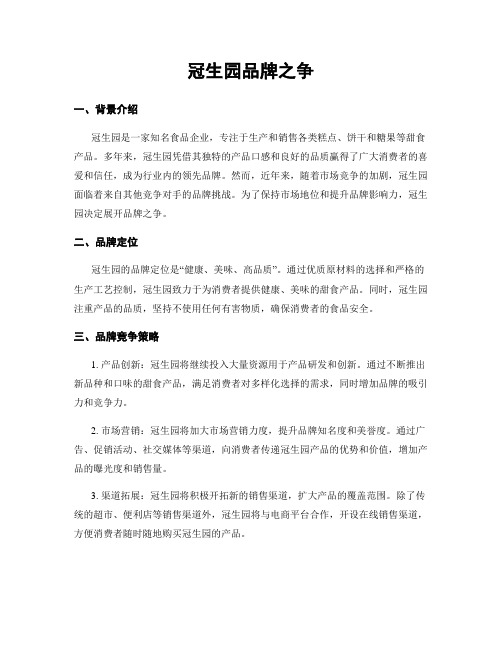
冠生园品牌之争一、背景介绍冠生园是一家知名食品企业,专注于生产和销售各类糕点、饼干和糖果等甜食产品。
多年来,冠生园凭借其独特的产品口感和良好的品质赢得了广大消费者的喜爱和信任,成为行业内的领先品牌。
然而,近年来,随着市场竞争的加剧,冠生园面临着来自其他竞争对手的品牌挑战。
为了保持市场地位和提升品牌影响力,冠生园决定展开品牌之争。
二、品牌定位冠生园的品牌定位是“健康、美味、高品质”。
通过优质原材料的选择和严格的生产工艺控制,冠生园致力于为消费者提供健康、美味的甜食产品。
同时,冠生园注重产品的品质,坚持不使用任何有害物质,确保消费者的食品安全。
三、品牌竞争策略1. 产品创新:冠生园将继续投入大量资源用于产品研发和创新。
通过不断推出新品种和口味的甜食产品,满足消费者对多样化选择的需求,同时增加品牌的吸引力和竞争力。
2. 市场营销:冠生园将加大市场营销力度,提升品牌知名度和美誉度。
通过广告、促销活动、社交媒体等渠道,向消费者传递冠生园产品的优势和价值,增加产品的曝光度和销售量。
3. 渠道拓展:冠生园将积极开拓新的销售渠道,扩大产品的覆盖范围。
除了传统的超市、便利店等销售渠道外,冠生园将与电商平台合作,开设在线销售渠道,方便消费者随时随地购买冠生园的产品。
4. 品牌形象塑造:冠生园将注重品牌形象的塑造和传播。
通过与知名美食博主、健康专家等合作,传递冠生园品牌的理念和价值观。
同时,冠生园将参与公益活动,展示企业的社会责任感,增强品牌的正面形象。
四、品牌推广活动1. 新品发布会:冠生园将定期举办新品发布会,邀请媒体和消费者参与。
通过展示新品的特点和优势,吸引媒体的报道和消费者的关注,提升品牌的知名度和美誉度。
2. 促销活动:冠生园将定期举办促销活动,如打折、满减、赠品等,吸引消费者前来购买。
同时,冠生园将与合作伙伴共同举办联合促销活动,扩大品牌的影响力和销售量。
3. 社交媒体营销:冠生园将加大在社交媒体平台的宣传力度。
冠生园品牌之争

冠生园品牌之争1. 背景介绍冠生园是一家知名的食品企业,专注于生产和销售各类休闲食品。
多年来,冠生园凭借其独特的产品口味和高品质的食品,赢得了广大消费者的喜爱和信任。
然而,近年来,冠生园面临着来自竞争对手的激烈竞争,品牌地位受到了一定的冲击。
为了保持市场份额和提升品牌影响力,冠生园决定展开一场品牌之争。
2. 目标冠生园的目标是通过品牌之争,提升品牌知名度和美誉度,以增加销量和市场份额。
通过差异化的产品定位和营销策略,冠生园希望能够在竞争激烈的市场中脱颖而出,成为消费者首选的休闲食品品牌。
3. 品牌定位冠生园将以“健康、美味、创新”为品牌定位,强调产品的高品质和独特口味。
冠生园将注重产品的原材料选择和生产工艺,确保产品的健康安全和口感美味。
同时,冠生园将不断推出新品种和新口味,满足消费者的多样化需求。
4. 市场调研冠生园将进行全面的市场调研,了解消费者对休闲食品的需求和偏好。
通过调研,冠生园将确定目标消费群体,了解其消费习惯和购买决策的关键因素。
同时,冠生园将关注竞争对手的产品特点和营销策略,以便制定有效的竞争对策。
5. 产品创新冠生园将加大产品研发力度,推出更多创新的休闲食品产品。
冠生园将注重产品的口感、包装和营养价值,以满足消费者对健康美味的追求。
冠生园将通过不断创新,提升产品的差异化竞争力,吸引更多消费者选择冠生园的产品。
6. 市场推广冠生园将通过多种渠道进行市场推广,提升品牌知名度和美誉度。
冠生园将加大线上线下广告投放,通过电视、网络、平面媒体等渠道进行品牌宣传。
同时,冠生园将积极参与各类展会和活动,增加品牌曝光度,吸引更多消费者的关注。
7. 渠道拓展冠生园将加强与各大超市和便利店的合作,扩大产品的销售渠道。
冠生园将与零售商进行合作,提供优惠政策和支持,以增加产品的陈列和销售量。
同时,冠生园将加大对线上销售渠道的投入,通过电商平台和社交媒体进行产品推广和销售。
8. 品牌形象塑造冠生园将注重品牌形象的塑造,提升品牌的美誉度和信任度。
冠生园品牌之争

冠生园品牌之争背景介绍:冠生园是一家知名的食品企业,专注于生产和销售各类休闲零食。
随着市场竞争的加剧,冠生园品牌面临着来自其他竞争对手的挑战。
为了保持竞争力并扩大市场份额,冠生园需要制定一套有效的品牌推广策略,以增强品牌形象和提高消费者认知度。
目标:冠生园希翼通过品牌之争活动来提升品牌知名度和消费者忠诚度,进而增加销售额。
具体目标如下:1. 提高品牌知名度:通过全面的市场推广活动,将冠生园品牌的知名度提升至行业前列。
2. 增加消费者忠诚度:通过品牌之争活动,增加消费者对冠生园品牌的认知和好感度,提高消费者忠诚度。
3. 增加销售额:通过品牌之争活动的推广,吸引更多消费者购买冠生园产品,从而提高销售额。
策略:1. 品牌定位:冠生园将定位为高品质、健康、创新的休闲零食品牌。
通过提供优质的产品和创新的口味,满足消费者对美味和健康的需求。
2. 市场调研:冠生园将进行市场调研,了解目标消费者的需求和偏好,以便更好地满足他们的需求,并制定相应的推广策略。
3. 品牌形象塑造:冠生园将通过多种渠道和媒体进行品牌形象塑造,包括电视广告、杂志广告、社交媒体推广等。
重点突出产品的高品质、健康和创新特点,吸引消费者的注意力。
4. 品牌合作:冠生园将与一些知名的健康食品品牌或者明星进行合作,共同推出联合产品或者进行品牌宣传活动,以提高品牌的知名度和美誉度。
5. 线下推广:冠生园将组织一系列线下推广活动,如品牌体验活动、特惠促销活动等,吸引消费者参预并购买冠生园产品。
6. 社交媒体推广:冠生园将加大在社交媒体平台的推广力度,通过发布有趣、实用的内容吸引粉丝,增加品牌暴光度和互动性。
7. 用户口碑营销:冠生园将鼓励消费者在社交媒体上分享自己对冠生园产品的好评和使用体验,通过用户口碑来增加品牌的认知度和信任度。
执行计划:1. 第一阶段(1个月):进行市场调研,了解目标消费者的需求和偏好,制定品牌推广策略。
2. 第二阶段(2个月):进行品牌形象塑造,制作电视广告、杂志广告等,通过各种媒体渠道推广品牌。
冠生园品牌之争
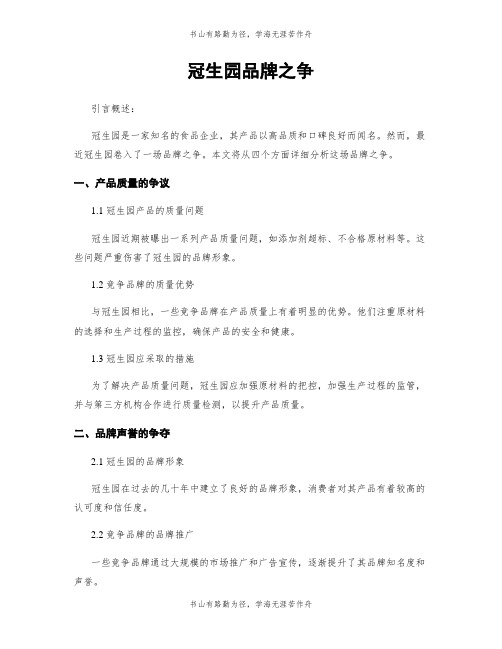
冠生园品牌之争引言概述:冠生园是一家知名的食品企业,其产品以高品质和口碑良好而闻名。
然而,最近冠生园卷入了一场品牌之争。
本文将从四个方面详细分析这场品牌之争。
一、产品质量的争议1.1 冠生园产品的质量问题冠生园近期被曝出一系列产品质量问题,如添加剂超标、不合格原材料等。
这些问题严重伤害了冠生园的品牌形象。
1.2 竞争品牌的质量优势与冠生园相比,一些竞争品牌在产品质量上有着明显的优势。
他们注重原材料的选择和生产过程的监控,确保产品的安全和健康。
1.3 冠生园应采取的措施为了解决产品质量问题,冠生园应加强原材料的把控,加强生产过程的监管,并与第三方机构合作进行质量检测,以提升产品质量。
二、品牌声誉的争夺2.1 冠生园的品牌形象冠生园在过去的几十年中建立了良好的品牌形象,消费者对其产品有着较高的认可度和信任度。
2.2 竞争品牌的品牌推广一些竞争品牌通过大规模的市场推广和广告宣传,逐渐提升了其品牌知名度和声誉。
2.3 冠生园的品牌重塑冠生园应加大品牌推广力度,通过与知名人士的合作、社交媒体的运营等方式,重新树立品牌形象,提升品牌声誉。
三、市场份额的争夺3.1 冠生园的市场占有率冠生园长期以来向来是市场的领导者,拥有较大的市场份额。
3.2 竞争品牌的崛起近年来,一些新兴品牌逐渐崛起,通过创新产品和市场定位,逐渐蚕食了冠生园的市场份额。
3.3 冠生园的市场拓展为了保持市场份额,冠生园应加大产品研发和市场拓展力度,推出更具竞争力的产品,并积极开辟新的市场领域。
四、消费者需求的变化4.1 消费者对食品安全的关注随着食品安全问题的频发,消费者对食品的安全性和健康性有着更高的要求。
4.2 消费者对品牌的选择消费者越来越注重品牌的信誉和口碑,他们更愿意选择有良好品牌形象的产品。
4.3 冠生园的回应冠生园应加强对产品质量的监管,提供透明的产品信息,与消费者建立更密切的联系,以满足消费者对食品安全和品牌选择的需求。
结语:冠生园品牌之争是一个复杂的问题,涉及产品质量、品牌形象、市场份额和消费者需求等多个方面。
冠生园品牌之争
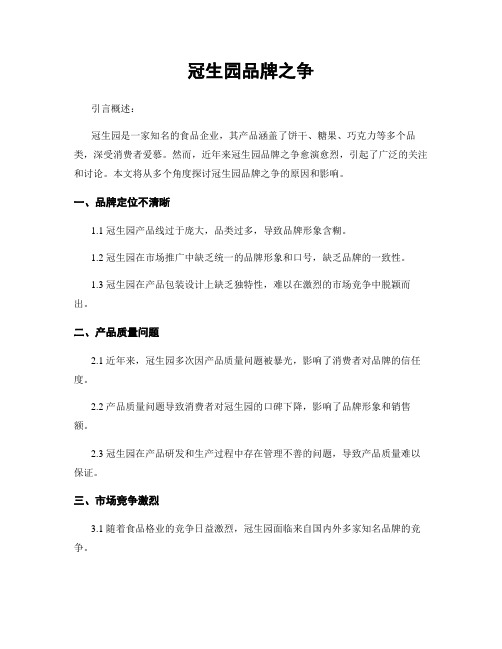
冠生园品牌之争引言概述:冠生园是一家知名的食品企业,其产品涵盖了饼干、糖果、巧克力等多个品类,深受消费者爱慕。
然而,近年来冠生园品牌之争愈演愈烈,引起了广泛的关注和讨论。
本文将从多个角度探讨冠生园品牌之争的原因和影响。
一、品牌定位不清晰1.1 冠生园产品线过于庞大,品类过多,导致品牌形象含糊。
1.2 冠生园在市场推广中缺乏统一的品牌形象和口号,缺乏品牌的一致性。
1.3 冠生园在产品包装设计上缺乏独特性,难以在激烈的市场竞争中脱颖而出。
二、产品质量问题2.1 近年来,冠生园多次因产品质量问题被暴光,影响了消费者对品牌的信任度。
2.2 产品质量问题导致消费者对冠生园的口碑下降,影响了品牌形象和销售额。
2.3 冠生园在产品研发和生产过程中存在管理不善的问题,导致产品质量难以保证。
三、市场竞争激烈3.1 随着食品格业的竞争日益激烈,冠生园面临来自国内外多家知名品牌的竞争。
3.2 冠生园在市场定位上缺乏差异化竞争优势,难以在同质化产品中脱颖而出。
3.3 冠生园在市场推广和营销方面投入不足,导致品牌知名度和市场份额下降。
四、管理层变动频繁4.1 冠生园近年来管理层变动频繁,导致企业战稍不稳定,影响了品牌发展方向。
4.2 管理层变动带来了组织结构和人员稳定性的问题,影响了企业内部管理和执行效率。
4.3 管理层变动对企业文化和品牌价值观的传承产生了负面影响,影响了员工忠诚度和团队凝结力。
五、品牌重塑之路5.1 冠生园需要重新审视品牌定位,精简产品线,梳理品牌形象,确立品牌核心价值。
5.2 冠生园需要加大产品研发和生产管理力度,提升产品质量和安全标准。
5.3 冠生园需要加大市场推广和营销投入,树立良好的品牌形象,提升品牌知名度和市场份额。
结语:冠生园品牌之争是一个复杂的问题,需要企业全面审视自身存在的问题,积极调整经营策略,重塑品牌形象,才干在激烈的市场竞争中立于不败之地。
希翼冠生园能够通过努力,重振品牌,重回辉煌。
冠生园品牌之争

冠生园品牌之争冠生园是一家知名的食品企业,专注于生产和销售各类糕点和饮品。
然而,近年来,冠生园品牌面临着激烈的竞争和品牌形象的争夺。
本文将从品牌定位、市场营销、产品创新等方面探讨冠生园品牌之争的现状和应对策略。
一、品牌定位冠生园作为一家具有悠久历史的食品企业,其品牌定位至关重要。
在品牌定位方面,冠生园应注重传统与现代的结合,强调产品的品质和口感,以及与消费者的情感共鸣。
冠生园可以通过提供健康、美味、方便的产品,满足现代消费者对于高品质生活的追求。
二、市场营销在市场营销方面,冠生园需要积极采取策略来提升品牌知名度和市场份额。
首先,冠生园可以通过多渠道的广告宣传来增加品牌暴光度,如电视、广播、互联网等。
其次,冠生园可以与知名的餐饮企业合作,推出联合品牌产品,提升品牌形象和销售额。
此外,冠生园还可以通过线上线下的促销活动,如限时折扣、赠品等,吸引更多消费者。
三、产品创新产品创新是冠生园在品牌之争中的关键因素之一。
冠生园应不断研发新产品,满足消费者的需求和口味变化。
例如,可以推出低糖、低脂的健康糕点,以迎合现代消费者对健康食品的追求。
此外,冠生园还可以引入新的口味和包装设计,增加产品的吸引力和竞争力。
四、品牌形象建设品牌形象的建设对于冠生园的品牌之争至关重要。
冠生园应注重品牌的可信度、稳定性和社会责任感。
可以通过与公益组织合作,参预社会公益活动,提升品牌的社会形象。
此外,冠生园还可以通过与知名人士合作,如明星代言人、名厨合作等,增加品牌的影响力和认可度。
五、消费者关系管理消费者关系管理是冠生园在品牌之争中的另一个关键因素。
冠生园应注重与消费者的互动和沟通,了解他们的需求和反馈。
可以通过建立客户服务热线、社交媒体平台等,与消费者进行及时的沟通和回应。
此外,冠生园还可以通过举办消费者活动、提供会员福利等方式,增强消费者的忠诚度和满意度。
六、竞争对手分析在品牌之争中,冠生园需要对竞争对手进行深入的分析,了解其优势和劣势,以制定相应的应对策略。
冠生园品牌之争

冠生园品牌之争引言概述:冠生园是中国知名的糕点品牌,多年来一直在市场上保持着领先地位。
然而,近年来,随着竞争的加剧,冠生园品牌之争日益激烈。
本文将从品牌定位、产品创新、市场推广、品牌形象和客户关系等五个大点,详细阐述冠生园品牌之争的现状和发展趋势。
正文内容:1. 品牌定位1.1 冠生园的品牌定位是高端糕点品牌,注重产品质量和口感。
1.2 冠生园在品牌定位上与其他竞争对手相比具有明显优势。
1.3 冠生园通过不断提升品牌形象和产品质量来巩固其高端品牌定位。
2. 产品创新2.1 冠生园在产品创新方面一直保持着领先地位。
2.2 冠生园不断研发新产品,满足消费者多样化的需求。
2.3 冠生园通过引入新的工艺和原料,提升产品口感和品质。
3. 市场推广3.1 冠生园通过广告、促销活动等多种方式进行市场推广。
3.2 冠生园注重线上线下的整合推广,提高品牌知名度和市场份额。
3.3 冠生园与知名人士合作,加强品牌形象的塑造和传播。
4. 品牌形象4.1 冠生园通过多年来的努力,建立了良好的品牌形象。
4.2 冠生园在品牌形象上注重传统与现代的结合,凸显文化底蕴。
4.3 冠生园通过参与公益活动等方式,提升品牌形象和社会责任感。
5. 客户关系5.1 冠生园注重与消费者的互动和沟通。
5.2 冠生园通过客户关系管理系统,建立起稳定的客户群体。
5.3 冠生园通过不断改进服务和产品,保持与消费者之间的良好关系。
总结:综上所述,冠生园在品牌之争中凭借其高端品牌定位、产品创新、市场推广、品牌形象和客户关系等方面的优势,保持了领先地位。
然而,随着竞争的加剧,冠生园仍需不断努力,不断提升自身实力和品牌形象,以保持市场竞争力和持续发展。
冠生园品牌之争

冠生园品牌之争冠生园是一家知名的食品企业,以生产和销售饼干、糕点等甜点食品而闻名。
然而,近年来,冠生园品牌在市场上的竞争日益激烈,面临着来自其他食品企业的挑战。
因此,冠生园需要制定一系列的品牌策略来提升其市场竞争力和品牌影响力。
1. 品牌定位冠生园需要明确自己的品牌定位,以便在市场中找到自己的独特位置。
可以考虑将冠生园定位为高品质、健康、创新的甜点品牌,强调产品的原材料优质、制作工艺精湛以及新颖的口味组合。
2. 产品研发与创新冠生园应该持续进行产品研发与创新,推出符合消费者需求的新品。
可以通过与专业厨师合作,引入新的食材和制作工艺,开发出更具创意和口感的甜点产品。
同时,冠生园还可以关注市场趋势,推出一些特殊的产品系列,如无糖、低糖、无麸质等,以满足不同消费者的需求。
3. 品牌形象塑造冠生园需要注重品牌形象的塑造,通过多样化的营销活动和渠道推广来增强品牌认知度。
可以考虑与知名美食博主合作,进行产品推荐和口碑营销。
此外,冠生园还可以参加食品展览会和美食节等活动,展示自己的产品和制作工艺,吸引更多消费者的关注。
4. 市场推广策略冠生园需要制定一系列的市场推广策略,以扩大市场份额和提高销售额。
可以通过电视、广播、报纸和杂志等传统媒体渠道进行广告宣传。
此外,冠生园还可以利用社交媒体平台,如微博、微信公众号和抖音等,与消费者进行互动,发布产品信息和促销活动,提升品牌知名度和影响力。
5. 品牌合作与联名推广冠生园可以考虑与其他知名品牌进行合作和联名推广,以提升品牌的影响力和吸引力。
可以与知名饮品品牌合作推出联名产品,或与知名零售商合作进行联合促销活动。
这样的合作不仅可以扩大产品销售渠道,还可以借助合作伙伴的品牌影响力,提升自身品牌形象。
6. 售后服务与用户体验冠生园需要注重售后服务和用户体验,提供优质的客户服务,以建立良好的品牌口碑。
可以建立客服热线和在线客服平台,及时回应消费者的问题和投诉。
此外,冠生园还可以通过举办品鉴会和消费者活动等形式,与消费者进行互动,了解他们的需求和意见,不断改进产品和服务。
冠生园品牌之争

冠生园品牌之争一、背景介绍冠生园是一家知名的食品企业,以生产和销售各类糕点、饼干和糖果而闻名。
然而,近年来,冠生园面临着来自竞争对手的激烈竞争,特别是在品牌认知度和市场份额方面。
为了应对这一挑战,冠生园决定展开一场品牌之争,以提升其品牌形象和市场竞争力。
二、品牌定位1. 目标市场:冠生园的目标市场主要是消费者群体中的年轻人和家庭。
这些人群对于食品的品质、口感和健康性有较高的要求。
2. 品牌形象:冠生园的品牌形象应以“健康、美味、创新”为核心理念。
通过提供高品质、天然、无添加的食品产品,满足消费者对健康和美味的需求。
3. 品牌价值观:冠生园的品牌价值观应强调诚信、质量和创新。
以可靠的品质、优质的服务和创新的产品来赢得消费者的信任和忠诚。
三、品牌推广策略1. 媒体宣传:通过电视、广播、报纸和杂志等传统媒体渠道,以及社交媒体平台如微博、微信等新媒体渠道进行品牌宣传。
制作精美的广告片和宣传画面,突出产品的特点和品牌形象,吸引消费者的注意力。
2. 产品创新:不断推出新品种、新口味的糕点、饼干和糖果,满足消费者对多样化产品的需求。
同时,注重产品的健康性和营养价值,符合现代人对健康生活的追求。
3. 促销活动:定期举办促销活动,如满减、赠品等,吸引消费者购买冠生园的产品。
同时,与其他品牌合作,进行联合促销,扩大品牌影响力和市场份额。
4. 线下推广:在商场、超市等消费场所设立展示台和试吃区,让消费者亲身体验冠生园的产品。
同时,与知名美食博主、网红合作,进行线下活动和推广,增加品牌的暴光度。
5. 品牌形象塑造:通过赞助体育赛事、文化活动等方式,提升冠生园的品牌形象和知名度。
同时,参预公益事业,为社会做出贡献,树立良好的企业形象。
四、品牌维护与管理1. 品牌口碑管理:加强对消费者反馈的采集和分析,及时回应消费者的意见和建议。
同时,通过客户关系管理系统,建立消费者数据库,进行个性化的营销和服务。
2. 品牌形象监测:定期进行品牌形象的调研和监测,了解消费者对品牌的认知和态度。
冠生园品牌之争

冠生园品牌之争引言概述:冠生园是一家知名的食品企业,其产品覆盖了面包、饼干、糕点等多个品类。
然而,近年来,冠生园品牌面临着激烈的竞争,市场份额逐渐被其他品牌侵蚀。
本文将从产品创新、品牌定位、市场拓展、营销策略以及品牌形象等五个方面,详细阐述冠生园品牌之争的现状和对策。
一、产品创新:1.1 引入新品类:冠生园可以考虑引入一些新的产品类别,例如健康食品或者有机食品,以满足现代消费者对健康和环保的追求。
1.2 提升产品品质:冠生园应该注重产品品质的提升,通过加强原材料的选择和生产工艺的优化,确保产品的口感和品质达到顾客的期望。
1.3 创新包装设计:冠生园可以通过创新包装设计来吸引消费者的眼球,提升产品的竞争力。
可以考虑与知名设计师合作,设计出独特且具有辨识度的包装。
二、品牌定位:2.1 定位年轻消费者:冠生园可以将品牌形象定位为年轻、时尚和健康的代表,通过与年轻人的品味和生活方式相契合,吸引更多的年轻消费者。
2.2 强调品质保证:冠生园可以通过品牌定位来强调产品品质的保证,例如强调采用优质原材料、严格的生产工艺和质量检测等,以建立消费者对品牌的信任。
2.3 打造独特形象:冠生园可以通过独特的品牌形象来与竞争对手区分开来,例如可以注重产品的创新性和个性化,以及与消费者的情感共鸣等。
三、市场拓展:3.1 开辟线上渠道:冠生园可以积极开辟线上渠道,通过电商平台和社交媒体等渠道与消费者建立更直接的联系,提升品牌暴光度和销售额。
3.2 拓展国际市场:冠生园可以考虑拓展国际市场,通过参加国际食品展览会、与海外代理商合作等方式,将产品推向全球消费者。
3.3 加强渠道合作:冠生园可以与其他相关行业的企业进行合作,例如与咖啡店、超市等建立合作关系,共同推广品牌和产品。
四、营销策略:4.1 优惠促销活动:冠生园可以定期举办优惠促销活动,例如限时折扣、满减等,吸引消费者试用产品并提升销量。
4.2 社交媒体营销:冠生园可以通过社交媒体平台开展营销活动,例如发布优质内容、与消费者互动等,提升品牌知名度和用户粘性。
南京冠生园重生之路另立品牌策划渠道
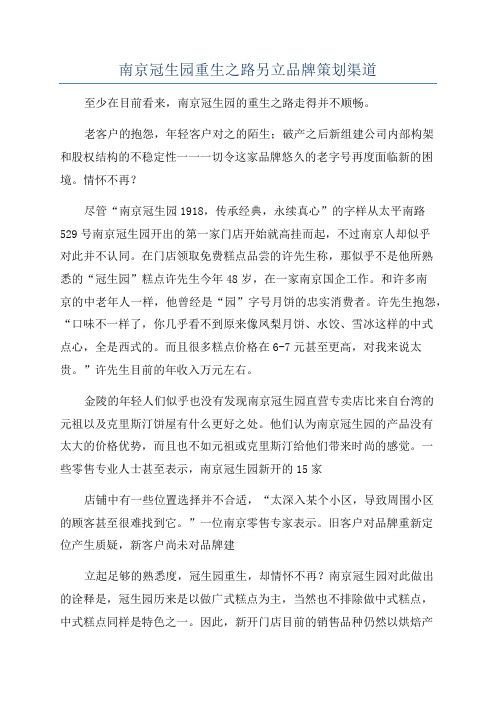
南京冠生园重生之路另立品牌策划渠道至少在目前看来,南京冠生园的重生之路走得并不顺畅。
老客户的抱怨,年轻客户对之的陌生;破产之后新组建公司内部构架和股权结构的不稳定性一一一切令这家品牌悠久的老字号再度面临新的困境。
情怀不再?尽管“南京冠生园1918,传承经典,永续真心”的字样从太平南路529号南京冠生园开出的第一家门店开始就高挂而起,不过南京人却似乎对此并不认同。
在门店领取免费糕点品尝的许先生称,那似乎不是他所熟悉的“冠生园”糕点许先生今年48岁,在一家南京国企工作。
和许多南京的中老年人一样,他曾经是“园”字号月饼的忠实消费者。
许先生抱怨,“口味不一样了,你几乎看不到原来像凤梨月饼、水饺、雪冰这样的中式点心,全是西式的。
而且很多糕点价格在6-7元甚至更高,对我来说太贵。
”许先生目前的年收入万元左右。
金陵的年轻人们似乎也没有发现南京冠生园直营专卖店比来自台湾的元祖以及克里斯汀饼屋有什么更好之处。
他们认为南京冠生园的产品没有太大的价格优势,而且也不如元祖或克里斯汀给他们带来时尚的感觉。
一些零售专业人士甚至表示,南京冠生园新开的15家店铺中有一些位置选择并不合适,“太深入某个小区,导致周围小区的顾客甚至很难找到它。
”一位南京零售专家表示。
旧客户对品牌重新定位产生质疑,新客户尚未对品牌建立起足够的熟悉度,冠生园重生,却情怀不再?南京冠生园对此做出的诠释是,冠生园历来是以做广式糕点为主,当然也不排除做中式糕点,中式糕点同样是特色之一。
因此,新开门店目前的销售品种仍然以烘焙产品为主,包括面包、蛋糕、曲奇、月饼等。
营业前期以销售面包、西点为主,到了7月份,正式开始生产月饼,重新打回冠生园的主业。
加强“冠生园”的品牌管理
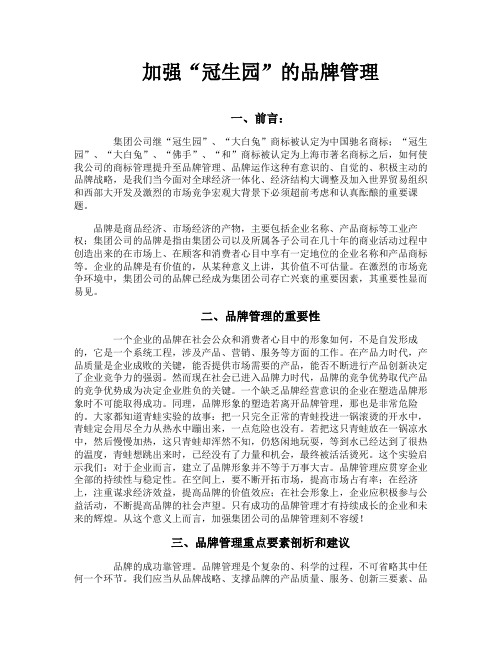
加强“冠生园”的品牌管理一、前言:集团公司继“冠生园”、“大白兔”商标被认定为中国驰名商标;“冠生园”、“大白兔”、“佛手”、“和”商标被认定为上海市著名商标之后,如何使我公司的商标管理提升至品牌管理、品牌运作这种有意识的、自觉的、积极主动的品牌战略,是我们当今面对全球经济一体化、经济结构大调整及加入世界贸易组织和西部大开发及激烈的市场竞争宏观大背景下必须超前考虑和认真酝酿的重要课题。
品牌是商品经济、市场经济的产物,主要包括企业名称、产品商标等工业产权;集团公司的品牌是指由集团公司以及所属各子公司在几十年的商业活动过程中创造出来的在市场上、在顾客和消费者心目中享有一定地位的企业名称和产品商标等。
企业的品牌是有价值的,从某种意义上讲,其价值不可估量。
在激烈的市场竞争环境中,集团公司的品牌已经成为集团公司存亡兴衰的重要因素,其重要性显而易见。
二、品牌管理的重要性一个企业的品牌在社会公众和消费者心目中的形象如何,不是自发形成的,它是一个系统工程,涉及产品、营销、服务等方面的工作。
在产品力时代,产品质量是企业成败的关键,能否提供市场需要的产品,能否不断进行产品创新决定了企业竞争力的强弱。
然而现在社会已进入品牌力时代,品牌的竞争优势取代产品的竞争优势成为决定企业胜负的关键。
一个缺乏品牌经营意识的企业在塑造品牌形象时不可能取得成功。
同理,品牌形象的塑造若离开品牌管理,那也是非常危险的。
大家都知道青蛙实验的故事:把一只完全正常的青蛙投进一锅滚烫的开水中,青蛙定会用尽全力从热水中蹦出来,一点危险也没有。
若把这只青蛙放在一锅凉水中,然后慢慢加热,这只青蛙却浑然不知,仍悠闲地玩耍,等到水已经达到了很热的温度,青蛙想跳出来时,已经没有了力量和机会,最终被活活烫死。
这个实验启示我们:对于企业而言,建立了品牌形象并不等于万事大吉。
品牌管理应贯穿企业全部的持续性与稳定性。
在空间上,要不断开拓市场,提高市场占有率;在经济上,注重谋求经济效益,提高品牌的价值效应;在社会形象上,企业应积极参与公益活动,不断提高品牌的社会声望。
冠生园品牌之争

冠生园品牌之争引言概述:冠生园作为中国知名的食品品牌之一,一直以来都备受消费者的喜爱。
然而,近年来,冠生园品牌之间的竞争日益激烈,各个品牌都在争夺市场份额。
本文将从产品品质、品牌形象、市场推广、消费者口碑和创新能力等五个大点阐述冠生园品牌之争的现状和趋势。
正文内容:1. 产品品质1.1 原材料选择:冠生园品牌之间的竞争主要体现在原材料的选择上。
各个品牌都在努力寻找高品质的原材料,以确保产品的口感和营养价值。
1.2 生产工艺:冠生园品牌之间的竞争还表现在生产工艺上。
每个品牌都在不断改进和创新生产工艺,以提高产品的质量和口感。
1.3 质量控制:冠生园品牌之争也体现在质量控制上。
各个品牌都建立了严格的质量控制体系,确保产品符合国家标准和消费者的期望。
2. 品牌形象2.1 品牌定位:冠生园品牌之争的一个重要方面是品牌定位。
每个品牌都有自己独特的品牌定位,以满足不同消费者的需求。
2.2 品牌传播:冠生园品牌之争还表现在品牌传播上。
各个品牌都在通过各种渠道和媒体进行品牌宣传和推广,以提高品牌知名度和美誉度。
2.3 品牌形象塑造:冠生园品牌之争还体现在品牌形象的塑造上。
每个品牌都在通过产品包装、广告语等手段来塑造自己独特的品牌形象,以吸引消费者的关注和认可。
3. 市场推广3.1 渠道拓展:冠生园品牌之争的一个重要方面是市场推广。
各个品牌都在积极拓展销售渠道,以增加产品的销售量和市场份额。
3.2 促销活动:冠生园品牌之争还表现在促销活动上。
各个品牌都会定期举办促销活动,以吸引消费者购买自己的产品。
3.3 市场调研:冠生园品牌之争还体现在市场调研上。
每个品牌都会进行市场调研,以了解消费者需求和市场趋势,从而制定更有效的市场推广策略。
4. 消费者口碑4.1 产品口感:冠生园品牌之争的一个重要方面是消费者口碑。
消费者对产品的口感有着很高的要求,各个品牌都在努力提供口感好的产品。
4.2 产品质量:消费者对产品质量的要求也是冠生园品牌之争的一个关键点。
冠生园品牌之争

冠生园品牌之争一、背景介绍冠生园是一家知名的食品企业,专注于生产和销售各类休闲食品,如薯片、饼干等。
多年来,冠生园凭借其独特的产品口味和优质的服务,赢得了广大消费者的喜爱与信赖,成为行业内的领军品牌之一。
然而,近年来,随着市场竞争的日益激烈,冠生园面临着来自同行业竞争对手的挑战。
竞争对手纷纷推出新品种、新口味,试图抢夺冠生园的市场份额。
为了保持自身竞争力并进一步拓展市场,冠生园迫切需要制定一套有效的品牌战略,以应对品牌之争。
二、品牌定位冠生园作为一家专注于休闲食品的企业,其产品特点在于独特的口味和优质的品质。
在品牌定位方面,冠生园应该坚持高品质、创新和健康的理念,以满足消费者对美味和健康的需求。
三、品牌传播策略1. 加大市场推广力度:冠生园可以通过多种渠道进行市场推广,如电视广告、户外广告、网络推广等。
广告内容应突出冠生园产品的独特口味和健康理念,吸引消费者的注意力。
2. 提升产品包装设计:冠生园可以重新设计产品包装,使其更加吸引消费者的眼球。
包装设计应与产品特点相符,突出品牌形象和产品的高品质。
3. 打造品牌形象:冠生园可以通过赞助活动、公益事业等方式来提升品牌形象。
参与公益事业可以增加品牌的社会责任感,树立良好的企业形象。
4. 加强线上销售渠道:随着电子商务的发展,冠生园可以加大对线上销售渠道的投入,提升产品的可及性和便捷性。
同时,冠生园可以在电商平台上进行促销活动,吸引更多消费者购买。
四、品牌保护策略1. 注册商标:冠生园应该及时注册自己的品牌商标,确保自身品牌的独立性和权益。
2. 加强知识产权保护:冠生园可以加强对产品配方、生产工艺等核心技术的保护,防止竞争对手盗取商业机密。
3. 加强售后服务:冠生园可以加强售后服务,提供消费者满意的购物体验。
及时解决消费者的投诉和问题,增强品牌的信誉度。
五、品牌发展战略1. 产品创新:冠生园可以不断推出新品种、新口味的休闲食品,满足消费者的多样化需求。
冠生园品牌之争

冠生园品牌之争一、背景介绍冠生园是一家知名的食品企业,专注于生产和销售各类糕点、饼干和面包等食品产品。
近年来,随着消费者对健康食品的需求增加,冠生园决定进一步提升品牌形象,以在竞争激烈的市场中保持领先地位。
然而,冠生园面临着来自其他竞争对手的品牌挑战,需要制定相应的品牌策略来应对。
二、目标设定1. 提升冠生园品牌形象和知名度;2. 增加消费者对冠生园产品的信任度;3. 扩大市场份额,增加销售额和利润。
三、品牌定位冠生园将定位为“健康、高品质、创新”的品牌形象。
通过提供健康食品,传递高品质和创新的产品理念,满足现代消费者对于健康生活方式的追求。
四、品牌策略1. 产品研发与创新:冠生园将加大对产品研发的投入,推出更多健康、营养且美味的新品。
同时,注重产品包装设计和口感的创新,以吸引消费者的注意力和口碑传播。
2. 品牌宣传与推广:a) 媒体广告:通过电视、网络和平面媒体等渠道进行品牌宣传,展示冠生园产品的特点和优势,营造品牌形象。
b) 社交媒体营销:利用微博、微信等社交媒体平台,与消费者进行互动,发布健康饮食知识和产品信息,增加品牌曝光度和粉丝互动。
c) 线下推广活动:举办品牌体验活动、赞助健康生活展览等,增加品牌与消费者的互动,提升品牌认知度。
3. 品牌合作与联名:与知名的健康食品品牌、健身俱乐部等进行合作,共同推出联名产品或举办联合活动,增加品牌的影响力和知名度。
4. 售后服务与口碑管理:冠生园将注重售后服务,提供优质的客户体验。
同时,积极管理和回应消费者的反馈和建议,及时解决问题,维护良好的口碑。
五、执行与评估1. 执行计划:制定详细的品牌推广计划,明确各项任务的时间表和责任人,确保落地执行。
2. 绩效评估:定期对品牌推广活动进行绩效评估,包括市场份额增长、销售额增加、消费者调研结果等。
根据评估结果,及时调整和优化品牌策略。
六、预期效果通过以上品牌策略的执行,冠生园预计能够取得以下预期效果:1. 品牌知名度提升:通过广告宣传和社交媒体推广,冠生园的品牌知名度将显著提升,进一步巩固市场领先地位。
- 1、下载文档前请自行甄别文档内容的完整性,平台不提供额外的编辑、内容补充、找答案等附加服务。
- 2、"仅部分预览"的文档,不可在线预览部分如存在完整性等问题,可反馈申请退款(可完整预览的文档不适用该条件!)。
- 3、如文档侵犯您的权益,请联系客服反馈,我们会尽快为您处理(人工客服工作时间:9:00-18:30)。
品牌管理与技术创新:南京新冠生园的品牌重塑与现代转型摘要:随着市场经济的快速发展,品牌成为企业参与市场竞争的核心力量;“老字号”企业也面临越来越严峻的生存压力。
本文基于百年“老字号”品牌南京冠生园的实地调查发现,中外合资南京冠生园因忽视品牌管理,百年老店毁于“陈陷”事件;而南京新冠生园通过重拾品牌管理实现品牌重塑,重视技术创新实现向现代企业跨越。
具体在品牌管理方面:一是重视传统继承,创新品牌理念;二是完善管理体系,重视人力资本;三是提高宣传力度,扩大品牌影响。
在技术创新方面:一方面规范生产质量管理,产品研发科学化;另一方面进行多元化产品销售,企业呈规模化发展。
南京新冠生园的成功蜕变显示了品牌管理对“老字号”企业发展的重要性;在依靠现代管理和技术创新同时,“老字号”企业需要重视对传统继承与发展,从而才能突破“老字号”发展瓶颈,实现可持续发展。
关键词:南京新冠生园;“陈陷”事件;品牌管理;技术创新;现代转型Brand Management and Technological Innovation: Brand Rebuilding and Modern Transformation of Nanjing New Guanshengyuan Abstract: With the rapid development of the market economy, the brand has become the core force of enterprises to participate in the market competition; “old” enterprises are also facing more and more severe survival pressure. Based on the field investigation about the century-old brand of Nanjing Guanshengyuan, the author finds out that Sino-foreign joint venture Nanjing Guanshengyuan neglected brand management, century-old shop was destroyed by “Chenxian”incident, and the new Nanjing guanshengyuan rebranding through to regain brand management, attention to technology innovation of modern enterprise. As for the brand management: firstly, pay attention to the traditional inheritance, innovation and brand concept; secondly, to improve the management system, pay attention to human capital; thirdly, to improve publicity efforts, expanded brand influence. In terms of technological innovation: on the one hand, production of quality management, product research and development science; the other hand, a wide range of product sales, enterprises were large-scale development. Nanjing guanshengyuan metamorphosis shows the new brand management for the "old" enterprise development the importance of relying on modern management and technology innovation at the same time, the "old" enterprise needs to take the inheritance and development of traditional, thereby to break "old" development bottlenecks and achieve sustainable development. The successful transformation of Nanjing New Guanshengyuan shows the importance of brand management to the development of “old”enterprises. While relying on modern management and technological innovation, “old”enterprises need to attach importance to the inheritance and development of traditions, thus breaking the bottlenec k of “old ” , to achieve sustainable development.Key words: Nanjing New Guanshengyuan, “Chenxian” Incident, Brand Management,Technological Innovation, Modern Transformation随着企业之间的竞争形式由产品力竞争向品牌力竞争的转变,品牌正成为企业掌握的最有效的竞争手段,相应地,有效的品牌管理亦成为企业制胜的关键①。
企业品牌管理最早来源于1931年宝洁公司的尼尔提出的“一个人负责一个品牌”的管理思想,并在此基础上逐渐形成较为系统的品牌管理理论。
如早期品牌管理思想,多是将品牌定义为经营者或者经营者集体的产品与服务,基于与其他竞争者有所区别而赋予之名称、术语、记号、象征、设计,亦或是上述方式结合②。
并在具体管理方式上更注重顾客满意度和企业品牌形象,并渐渐的形成以日本学者小林太三郎为代表的“企业性格论”,也就是后来的“企业个性论”。
到了90年代后,品牌成为企业重要的战略资源,在其管理上也更加注重沟通互动和其核心影响力的提升。
并且还提出品牌管理要随时代的变化而有相适应的变化。
“老字号”企业是城市文化积淀的重要载体,在城市的发展中担当着重要角色。
但是随着科学的发展和技术的进步以及人们消费习惯的变化,大量的“老字号”企业在对私改造和市场的竞争中,逐渐被淘汰,据统计,我国解放初期“老字号”企业大约有8000家,到1990年商务部核定“中华老字号”企业只剩1600家③。
所以如何创新发展,实现“老字号”企业向现代品牌的跨越是当下“老字号”研究的重要议题。
学者张继焦基于事实研究表明,城市中的“老字号”、“老商街”是承载民族传统文化的实体和象征,在城市化发展过程中需要得到关注与保护,并实现两者之间的和谐发展④。
刘希宋、杨铭铎等在研究餐饮“老字号”的经济价值和文化价值时提出餐饮“老字号”发展的瓶颈在于品牌管理,从传统继承、创新、品牌“双重保护”、品牌提升等四个方面,提出了餐饮老字号的品牌管理方法⑤。
明洁、姜小琴通过对江苏老字号企业的研究,分析得出企业技术创新是企业现代转型的重要手段,并在此基础上提出“老字号”企业技术创新发展策略⑥。
①李晓青,周勇.中外企业品牌管理研究综述[J].商业研究,2005(21):77—78②张燚,张锐.国内外品牌本性理论研究综述[J].北京工商大学学报(社会科学版),2004,19(01):50—52③汪振和,张雁宁,徐震中.南京老字号[M].南京:南京大学出版社,2014:1—2④张继焦.城市转型中的老字号、老商街:首尔与北京的比较[J].北方民族大学学报(哲学社会科学版),2016(04):17—18⑤刘希宋,杨铭铎,邵雯.老字号的品牌效益与品牌管理[J].商业时代,2006(03):42—43⑥明洁,姜小琴.江苏老字号企业技术创新发展策略[J].商业研究,2009(11):199—201因而品牌管理和技术创新成为“老字号”企业向现代企业跨越的重要手段。
笔者于2014年8月、2016年6月通过访谈法、观察法以及文献法等方法多次对南京“老字号”冠生园进行实地调查,在调查中了解到,南京冠生园于1918年由广东人冼冠生在上海创立,主要经营粤式茶食、蜜饯、糖果等,本着“本心、本领、本钱”的三本主义使得冠生园迅速发展,在1924年成立南京分分店;1985年后南京冠生园产品在全国市场占有率大幅上升,逐渐成为国内知名品牌。
然而2001年“陈陷”事件使得中外合资南京冠生园宣布破产。
直到2004年康海药业收购了南京冠生园后,重新组建南京新冠生园;通过加强品牌管理实现南京新冠生园的品牌重塑,并依靠技术创新逐渐向现代企业转型。
因此,笔者试图通过对南京新冠生园的品牌重塑与现代转型探究,来分析“老字号”企业品牌管理的重要性和寻找“老字号”企业向现代企业跨越的有效手段。
一、忽视品牌管理:百年老店毁于“陈馅”事件南京冠生园是南京食品“老字号”品牌,迄今已有近百年的历史。
创立于1924年,当时隶属于冼冠生创立的冠生园食品股份有限公司,主要经营月饼、糖果等产品。
在1934年,为其品牌月饼聘请影后胡蝶为形象代言人和合伙人,使得冠生园很快成为国内驰名品牌。
1937年抗日战争爆发后,冠生园创始人冼冠生亲赴重庆选址开设重庆分公司,并设立门市和餐饮部,逐渐成为当时大宴小酌的首选场所。
解放后,全国企业进行私有制改革,冼氏控股的冠生园股份有限公司解体,各地分店企业都隶属于地方,与上海冠生园再无联系。
此时,南京冠生园与“瑞记面包房”、“马庆康”合并成立了公私合营南京冠生园食品厂,拥有大行宫、碑亭巷和中山路3个门市店。
1958年,“建民食品社”和“玄武区政府食品加工厂”也被并入公私合营南京冠生园食品厂。
1985年,公司引进日本、意大利等国食品机械设备,开始走上机械化、规模化生产,大大提升了冠生园食品的品质。
同时增加了产品种类,拓展新市场,逐渐发展成为江苏地区民品产品。
